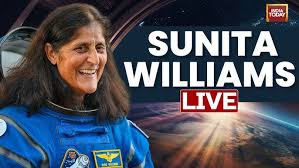Sunita Williams, a name synonymous with courage, determination, and excellence, is one of the most celebrated astronauts of Indian origin. Her journey from a small town in the United States to the vast expanse of space is a testament to human resilience and the power of dreams. This article delves into her life, achievements, and the profound impact she has had on space exploration, science, and society.
1. Early Life and Background
Family Roots and Childhood
Sunita Lyn Williams was born on September 19, 1965, in Euclid, Ohio, to Indian-American parents. Her father, Dr. Deepak Pandya, was a renowned neuroanatomist, and her mother, Bonnie Pandya, was of Slovenian descent. Sunita’s Indian heritage played a significant role in shaping her identity, and she often speaks fondly of her visits to India.
Education and Early Interests
Sunita attended Needham High School in Massachusetts, where she excelled in academics and sports. She developed a passion for swimming, which later proved invaluable during her space missions. She graduated with a Bachelor of Science in Physical Science from the United States Naval Academy in 1987 and later earned a Master of Science in Engineering Management from the Florida Institute of Technology in 1995.
2. Naval Career and Path to NASA
Service in the U.S. Navy
Sunita Williams joined the U.S. Navy in 1987 and became a helicopter pilot, logging over 3,000 flight hours in more than 30 different aircraft. Her exceptional skills and leadership qualities earned her numerous accolades, including the Navy Commendation Medal and the Navy and Marine Corps Achievement Medal.
Selection as an Astronaut
In June 1998, Sunita was selected by NASA for astronaut training. Her background in engineering, aviation, and physical fitness made her an ideal candidate. She completed rigorous training in spacewalks, robotics, and spacecraft systems, preparing her for the challenges of space exploration.
3. Space Missions and Achievements
Expedition 14/15 (2006–2007)
Sunita’s first space mission began on December 9, 2006, when she launched aboard the Space Shuttle Discovery to the International Space Station (ISS). During her 195-day stay, she set several records:
- Longest spaceflight by a woman at the time.
- Most spacewalks by a woman (four spacewalks totaling 29 hours and 17 minutes).
- Longest single spacewalk by a woman (7 hours and 31 minutes).
Her mission involved critical tasks such as installing new components, conducting scientific experiments, and maintaining the ISS.
Expedition 32/33 (2012)
Sunita returned to space on July 15, 2012, as part of Expedition 32/33. She served as the Commander of the ISS, becoming only the second woman to hold this position. During this mission, she spent 127 days in space, further solidifying her legacy as a trailblazer.
Key Contributions
- Scientific Research: Conducted experiments in biology, physics, and materials science.
- Spacewalks: Performed critical repairs and upgrades to the ISS.
- Public Outreach: Inspired millions through her educational outreach programs.
4. Records and Milestones
Sunita Williams holds several records that highlight her extraordinary contributions to space exploration:
- Most spacewalks by a woman (seven spacewalks totaling 50 hours and 40 minutes).
- Longest cumulative spacewalk time by a woman.
- First person to run a marathon in space (2007 Boston Marathon on a treadmill aboard the ISS).
5. Personal Life and Interests
Family and Hobbies
Sunita is married to Michael J. Williams, a federal police officer. She enjoys running, swimming, and cycling, which she credits for maintaining her physical and mental fitness during space missions.
Connection to India
Sunita takes immense pride in her Indian heritage. She carried a copy of the Bhagavad Gita, a samosa, and other Indian mementos to space. Her visits to India have inspired countless young Indians to pursue careers in science and technology.
6. Challenges and Overcoming Adversity
Physical and Mental Challenges
Space missions demand immense physical and mental strength. Sunita endured the effects of microgravity, isolation, and the risks of spacewalks. Her rigorous training and resilience enabled her to overcome these challenges.
Breaking Barriers
As a woman of Indian origin in a male-dominated field, Sunita faced societal and cultural barriers. However, her determination and excellence shattered stereotypes, paving the way for future generations.
7. Legacy and Impact
Inspiration to Millions
Sunita Williams has become a global icon, inspiring millions, especially women and people of Indian origin, to dream big and pursue careers in STEM (Science, Technology, Engineering, and Mathematics).
Contributions to Space Exploration
Her work on the ISS has advanced our understanding of space and its potential for scientific discovery. She has also contributed to the development of technologies for future missions to the Moon and Mars.
Advocacy for Education
Sunita actively engages in educational outreach, encouraging students to explore science and space. Her efforts have sparked interest in space exploration among young minds worldwide.
8. Future Endeavors
Sunita Williams continues to work with NASA, contributing to the Artemis program, which aims to return humans to the Moon and eventually send them to Mars. Her expertise and experience make her a valuable asset to these ambitious missions.
Conclusion: A Star Among Us
Sunita Williams’ journey from a small-town girl to a celebrated astronaut is a story of perseverance, passion, and purpose. Her achievements have not only advanced space exploration but also inspired countless individuals to reach for the stars. As we look to the future of space travel, Sunita’s legacy will continue to shine brightly, reminding us that no dream is too big and no goal is out of reach.
